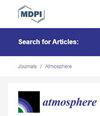Evaluation of Rainfall Erosivity in the Western Balkans by Mapping and Clustering ERA5 Reanalysis Data
IF 2.3
4区 地球科学
Q3 ENVIRONMENTAL SCIENCES
引用次数: 3
Abstract
The Western Balkans (WB) region is highly prone to water erosion processes, and therefore, the estimation of rainfall erosivity (R-factor) is essential for understanding the complex relationships between hydro-meteorological factors and soil erosion processes. The main objectives of this study are to (1) estimate the spatial-temporal distribution R-factor across the WB region by applying the RUSLE and RUSLE2 methodology with data for the period between 1991 and 2020 and (2) apply cluster analysis to identify places of high erosion risk, and thereby offer a means of targeting suitable mitigation measures. To assess R-factor variability, the ERA5 reanalysis hourly data (0.25° × 0.25° spatial resolution) comprised 390 grid points were used. The calculations were made on a decadal resolution (i.e., for the 1990s, the 2000s, and the 2010s), as well as for the whole study period (1991–2020). In order to reveal spatial patterns of rainfall erosivity, a k-means clustering algorithm was applied. Visualization and mapping were performed in python using the Matplotlib, Seaborn, and Cartopy libraries. Hourly precipitation intensity and monthly precipitation totals exhibited pronounced variability over the study area. High precipitation values were observed in the SW with a >0.3 mm h−1 average, while the least precipitation was seen in the Pannonian Basin and far south (Albanian coast), where the mean intensity was less than an average of 0.1 mm h−1. R-factor variability was very high for both the RUSLE and RUSLE2 methods. The mean R-factor calculated by RUSLE2 was 790 MJ mm ha−1·h−1·yr−1, which is 58% higher than the mean R-factor obtained from RUSLE (330 MJ mm ha−1·h−1·yr−1). The analysis of the R-factor at decadal timescales suggested a rise of 14% in the 2010s. The k-means algorithm for both the RUSLE and RUSLE2 methods implies better spatial distribution in the case of five clusters (K = 5) regarding the R-factor values. The rainfall erosivity maps presented in this research can be seen as useful tools for the assessment of soil erosion intensity and erosion control works, especially for agriculture and land use planning. Since the R-factor is an important part of soil erosion models (RUSLE and RUSLE2), the results of this study can be used as a guide for soil control works, landscape modeling, and suitable mitigation measures on a regional scale.ERA5再分析数据的制图和聚类评估西巴尔干地区的降雨侵蚀性
西巴尔干地区极易发生水土流失过程,因此,对降雨侵蚀力(R因子)的估计对于理解水文气象因素与土壤侵蚀过程之间的复杂关系至关重要。本研究的主要目标是(1)通过应用RUSLE和RUSLE2方法以及1991年至2020年期间的数据,估计整个世界银行区域的时空分布R因子;(2)应用聚类分析来确定侵蚀风险高的地方,从而提供一种针对适当缓解措施的方法。为了评估R因子变异性,使用了由390个网格点组成的ERA5再分析小时数据(0.25°×0.25°空间分辨率)。这些计算是基于十年分辨率(即20世纪90年代、21世纪初和2010年代)以及整个研究期间(1991-2020年)进行的。为了揭示降雨侵蚀力的空间格局,应用了k均值聚类算法。可视化和映射是在python中使用Matplotlib、Seaborn和Cartopy库执行的。研究区域的小时降水强度和月降水总量表现出明显的可变性。西南部的降水量较高,平均值>0.3 mm h−1,而潘诺尼亚盆地和遥远的南部(阿尔巴尼亚海岸)的降水量最少,那里的平均强度小于0.1 mm h−1。RUSLE和RUSLE2方法的R因子变异性都很高。RUSLE2计算的平均R因子为790 MJ mm ha−1·h−1·yr−1,比RUSLE获得的平均R系数(330 MJ mm ha-1·h−1.yr−)高58%。在十年尺度上对R因子的分析表明,2010年代R因子上升了14%。RUSLE和RUSLE2方法的k均值算法意味着在关于R因子值的五个聚类(k=5)的情况下具有更好的空间分布。本研究中提供的降雨侵蚀力图可以被视为评估土壤侵蚀强度和侵蚀控制工作的有用工具,特别是对于农业和土地利用规划。由于R因子是土壤侵蚀模型(RUSLE和RUSLE2)的重要组成部分,本研究的结果可作为区域范围内土壤控制工程、景观建模和适当缓解措施的指南。
本文章由计算机程序翻译,如有差异,请以英文原文为准。
求助全文
约1分钟内获得全文
求助全文
来源期刊

Atmosphere
METEOROLOGY & ATMOSPHERIC SCIENCES-
CiteScore
4.60
自引率
13.80%
发文量
1769
审稿时长
1 months
期刊介绍:
Atmosphere (ISSN 2073-4433) is an international and cross-disciplinary scholarly journal of scientific studies related to the atmosphere. It publishes reviews, regular research papers, communications and short notes, and there is no restriction on the length of the papers. Our aim is to encourage scientists to publish their experimental and theoretical research in as much detail as possible. Full experimental and/or methodical details must be provided for research articles.
 求助内容:
求助内容: 应助结果提醒方式:
应助结果提醒方式:


